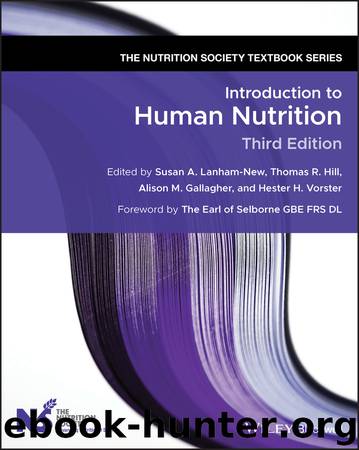Introduction to Human Nutrition by Susan A. Lanham-New & Thomas R. Hill & Alison M. Gallagher & Hester H. Vorster

Author:Susan A. Lanham-New & Thomas R. Hill & Alison M. Gallagher & Hester H. Vorster
Language: eng
Format: epub
ISBN: 9781119477020
Publisher: Wiley
Published: 2019-10-31T00:00:00+00:00
Vitamin D toxicity
Toxicity is seen when plasma calcidiol exceeds 500 nmol/l. In children, clinical signs of rickets are seen when plasma calcidiol falls below 20 nmol/l. Intoxication with vitamin D causes weakness, nausea, loss of appetite, headache, abdominal pains, cramp and diarrhoea. More seriously, it also causes hypercalcaemia, with plasma concentrations of calcium between 2.75 and 4.5 mmol/l, compared with the normal range of 2.2–2.5 mmol/l. which results in calcinosis (deposition of calcium in soft tissues including kidney, heart, lungs and blood vessels), diffuse demineralisation of bones and irreversible renal and cardiovascular toxicity. Hypercalcaemia can also lead to hypercalcinuria, which may result in the precipitation of calcium phosphate in the renal tubules and the development of urinary calculi. Above a serum calcium concentration of 3.75 mmol/l, vascular smooth muscle may contract abnormally, leading to hypertension. Hypercalcaemia has been reported at plasma concentration above 375‐500 nmol/l.
During the 1950s, rickets was more or less totally eradicated in Britain and other temperate countries. This was due to enrichment of a large number of infant foods with vitamin D. However, a small number of infants suffered from vitamin D poisoning, the most serious effect of which is an elevated plasma concentration of calcium. This can lead to contraction of blood vessels, and hence dangerously high blood pressure, and calcinosis – the calcification of soft tissues.
Some infants are sensitive to intakes of vitamin D as low as 45 μg/day. To avoid the serious problem of vitamin D poisoning in these susceptible infants, the extent to which infant foods are fortified with vitamin D has been reduced considerably. Unfortunately, this means that a proportion of infants (about 10%), who have relatively high requirements, are now at risk of developing rickets. The problem is to identify those who have higher requirements and provide them with supplements.
The tolerable upper level of intake is 100 μg/day for adults and 25 μg/day for infants. A small number of infants have been reported who developed hypercalcaemia at normal levels of vitamin D intake; they had defects in the 24‐hydroxylase that inactivates calcitriol. Reports of hypercalcaemia in adults have involved intakes in excess of 1000 μg/day.
Although excess dietary vitamin D is toxic, excessive exposure to sunlight does not lead to vitamin D poisoning. There is a limited capacity to form 7‐dehydrocholesterol in the skin, and a limited capacity to take up cholecalciferol from the skin. Furthermore, prolonged exposure of previtamin D to UV light results in further reactions to yield lumisterol and other biologically inactive compounds.
Download
This site does not store any files on its server. We only index and link to content provided by other sites. Please contact the content providers to delete copyright contents if any and email us, we'll remove relevant links or contents immediately.
| Anatomy | Bacteriology |
| Biochemistry | Biostatistics |
| Biotechnology | Cell Biology |
| Embryology | Epidemiology |
| Genetics | Histology |
| Immunology | Microbiology |
| Neuroanatomy | Nosology |
| Pathophysiology | Physiology |
| Virology |
Tuesdays with Morrie by Mitch Albom(4403)
Yoga Anatomy by Kaminoff Leslie(4103)
Science and Development of Muscle Hypertrophy by Brad Schoenfeld(3971)
Bodyweight Strength Training: 12 Weeks to Build Muscle and Burn Fat by Jay Cardiello(3781)
Introduction to Kinesiology by Shirl J. Hoffman(3626)
How Music Works by David Byrne(2964)
Sapiens and Homo Deus by Yuval Noah Harari(2843)
The Plant Paradox by Dr. Steven R. Gundry M.D(2427)
Insomniac City by Bill Hayes(2396)
Churchill by Paul Johnson(2364)
Coroner's Journal by Louis Cataldie(2359)
The Chimp Paradox by Peters Dr Steve(2225)
Hashimoto's Protocol by Izabella Wentz PharmD(2203)
The Universe Inside You by Brian Clegg(2048)
The Immune System Recovery Plan by Susan Blum(1967)
Don't Look Behind You by Lois Duncan(1915)
The Hot Zone by Richard Preston(1910)
Endure by Alex Hutchinson(1872)
Woman: An Intimate Geography by Natalie Angier(1842)
